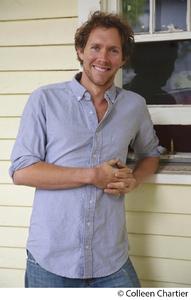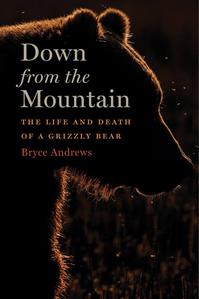 Bryce Andrews is the author of Badluck Way and Down from the Mountain: The Life and Death of a Grizzly Bear. The latter, out now from Houghton Mifflin Harcourt (reviewed below), follows Andrews as he works with a Montana farmer to protect a corn field from encroaching grizzlies. It explores the dangers bears and humans pose to each other, and how development is making possible encounters between the two more likely. Andrews has won the Reading the West Book Award for nonfiction and was a finalist for the Washington State Book Award. He currently works with the conservation group People and Carnivores.
Bryce Andrews is the author of Badluck Way and Down from the Mountain: The Life and Death of a Grizzly Bear. The latter, out now from Houghton Mifflin Harcourt (reviewed below), follows Andrews as he works with a Montana farmer to protect a corn field from encroaching grizzlies. It explores the dangers bears and humans pose to each other, and how development is making possible encounters between the two more likely. Andrews has won the Reading the West Book Award for nonfiction and was a finalist for the Washington State Book Award. He currently works with the conservation group People and Carnivores.
You used to be a rancher who now works for a nonprofit group that helps bears and humans live more successfully in close proximity. Tell us about your trajectory from one to the other.
To understand my trajectory, it helps to know that I didn't start out as a rancher. I grew up in the middle of Seattle, far away from agriculture and the world that I live in now. But early on I had an affinity toward conservation and the idea that wild spaces and creatures are worthy of our protection. After college, I worked as a ranch hand in valleys that border some of our last true wildernesses. I got to know these wild places much more intimately than I had as a kid in the city, and after a while, the animals I became most curious about were not the ones I was raising, but the ones that lived in the mountains. Today, I believe that wild animals are absolutely essential and worth saving--even when they cause us trouble. I'm pursuing that idea through my nonprofit work with the conservation group People and Carnivores in areas where wilderness meets agriculture.
Your book focuses on encounters between wild bears and humans who farm areas of land that brush up against the bears' habitats. You go into detail about one bear in particular, Millie, who was wounded by a gun. We often think of bears as being dangerous to humans, but what dangers do we pose to bears?
Basically, dangers arise from collisions--accidents on the highway, chance encounters with hunters in the mountains and moments where a bear's natural desire to feed runs headlong into something like a dairy, an orchard or an unprotected chicken coop. More often than not, bears who turn to eating domestic livestock and crops end up dead. As more people move to areas where grizzlies live, and the bears begin returning to territory now occupied by farms and ranches, such outcomes become harder to avoid. People and Carnivores takes into account the needs of bears and people to find ways to help both.
Your book is beautifully written and touches on so many themes of conservation, but at heart, it's a story about building a fence around a field of corn to keep out bears. How did you know that such a straightforward task as building a fence could be the subject for a whole book?
My work as a rancher taught me that there's a lot of complexity in simple actions like building a fence. Doing that work becomes a point of access into something much larger--our human relationship to the wilderness and to the landscape of the West. A through-line in our collective storytelling about the American West is that it's a landscape of work and wind and often injustice. This book picks up on those themes.
 But I wasn't certain that this story would make a book until I saw camera footage of Millie's ruined face. I remember it so vividly. I'd never seen anything like it in a decade of ranching, and I've seen some very hard things. I thought then that people needed to know about her, and understand how she met her end. We have these heroic stories about farming and taming the West, about self-reliance, necessary violence and human toughness, but they come at the expense of other equally true narratives which have to do with damage: damage to wild animals, to landscape, to native peoples, to families. What happened with the fence and Millie is a microcosm of certain things that are taking place across the West today. Her story is a lens for looking at these larger issues.
But I wasn't certain that this story would make a book until I saw camera footage of Millie's ruined face. I remember it so vividly. I'd never seen anything like it in a decade of ranching, and I've seen some very hard things. I thought then that people needed to know about her, and understand how she met her end. We have these heroic stories about farming and taming the West, about self-reliance, necessary violence and human toughness, but they come at the expense of other equally true narratives which have to do with damage: damage to wild animals, to landscape, to native peoples, to families. What happened with the fence and Millie is a microcosm of certain things that are taking place across the West today. Her story is a lens for looking at these larger issues.
The sections of your book that are written from Millie's perspective are very moving. As a writer, what kind of research did you do for those parts?
I did everything I could do to understand the particulars of her story. I looked at the GPS collar data that had been taken earlier in her life. That data shows where she went seasonally to get the best food sources, and how she used the landscape of the Mission Valley. I talked with the biologists who knew her best. I also spoke with the investigator who was looking into her maiming. I basically did all of the due diligence that I could to know what was known about this animal. But that only takes you so far. You can't go up to a grizzly bear and ask what it's like to be them. You can't follow them into their den and watch how they feed their cubs. Those things are largely unknown. So the "Millie" sections took a certain degree of creativity. Luckily, my decade's worth of raising livestock in landscapes that have grizzly bears gave me a good understanding of how grizzlies move, act and forage.
At the end of your book, a Wildlife Rehabilitation Center manager named Lisa says that "a famous bear has a better chance than one that nobody knows about." I couldn't help but think of how your book is bringing more attention to Millie and her cubs, and maybe to grizzly bears more generally. What is your hope for this book?
I hope that it makes people think differently about bears and how we relate to them. I want the book to make us think deeply and critically about how we develop and live in western landscapes. But perhaps most importantly I hope that this book helps people to think about the life and death of an individual wild animal. The story of pretty much any grizzly bear in the American West would blow your mind. Their lives and deaths are dramatic and interesting. I hope that once people understand those lives better, they will value them more. --Amy Brady, freelance writer and editor

